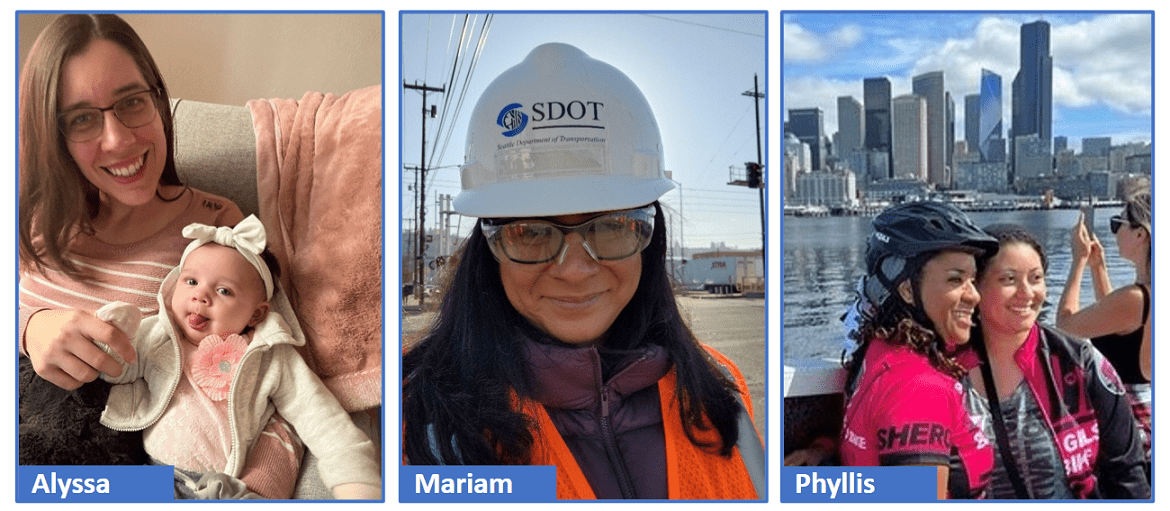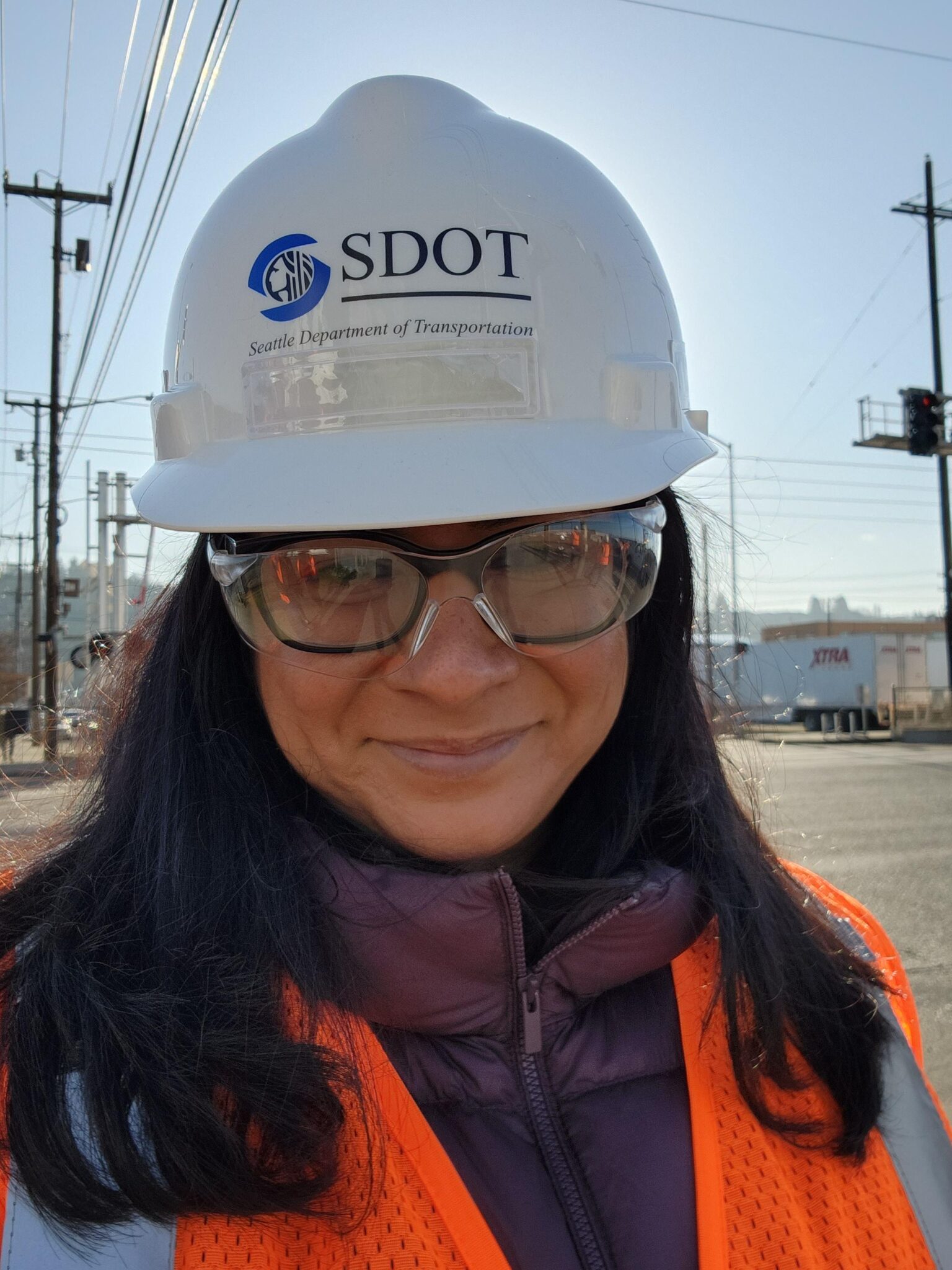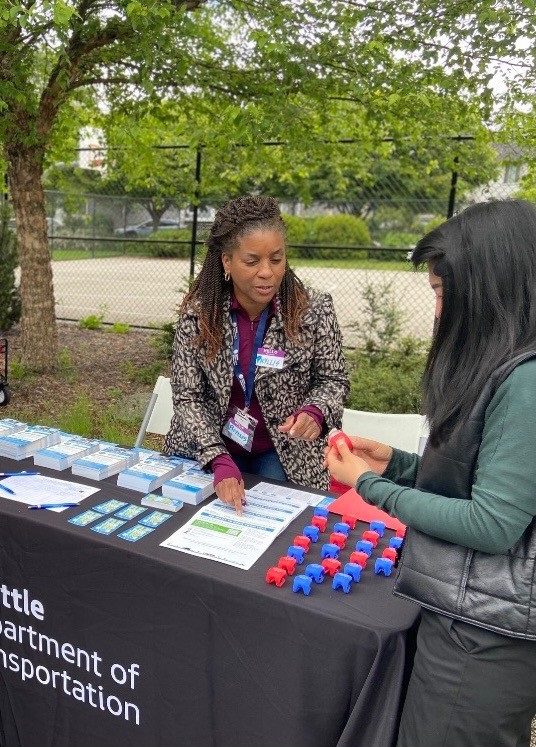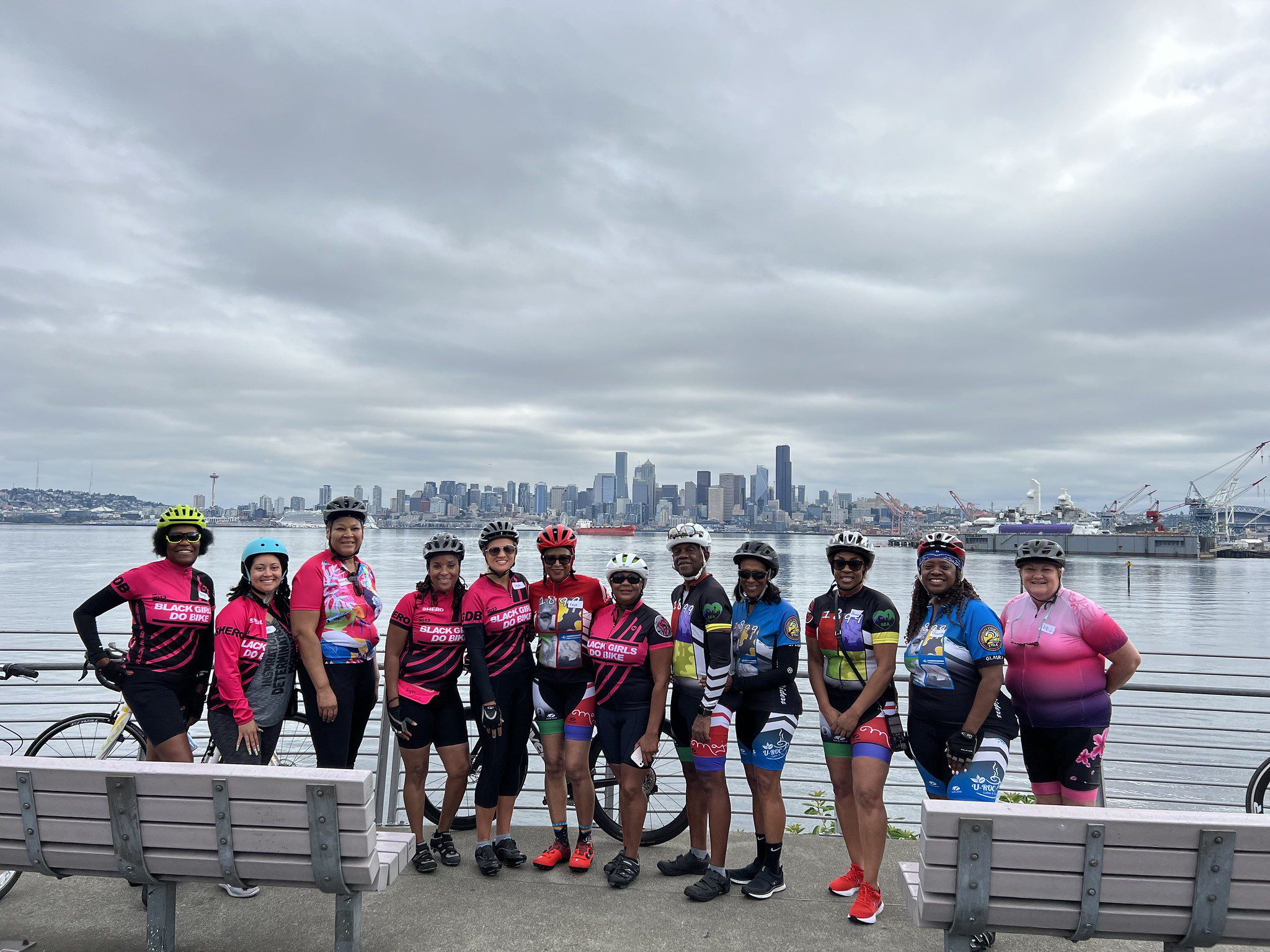 Photo collage: Alyssa with her daughter (left), Mariam wearing an SDOT hard hat (center), and Phyllis with her daughter (right). Photo credit: Alyssa Escobedo, Mariam Ali, and Phyllis Porter.
Photo collage: Alyssa with her daughter (left), Mariam wearing an SDOT hard hat (center), and Phyllis with her daughter (right). Photo credit: Alyssa Escobedo, Mariam Ali, and Phyllis Porter. Blog stats: 1,800 words | 10-minute read
At-a-Glance:
- March is Women’s History Month and we’re highlighting a few people here in Seattle who are setting a positive example for women working in transportation.
- Here at SDOT, we support everyone traveling throughout Seattle and work to make sure every voice is heard and represented.
Editor’s Note: This blog post was written by SDOT Communications Interns Maddie Dewhirst and Neha Chinwalla, in close collaboration with the three women highlighted within.
Since 1987, the United States has celebrated Women’s History Month to better recognize women and their accomplishments across the country. While we celebrate, it is important to acknowledge women from all backgrounds including women of color, trans women, and folks who identify as LGBTQ+ and non-binary. This representation is key to making sure everyone is included and we can all learn from these diverse stories.
The theme for 2023 is: Celebrating Women Who Tell Our Stories. In this blog post, we’re celebrating the theme by sharing the stories of three women who work at the Seattle Department of Transportation (SDOT) and the Seattle Department of Neighborhoods. They are among the many women working at the City of Seattle and in transportation across the country and world – and we celebrate their stories too.
Meet Alyssa Escobedo, a civil engineer from our Roadway Structures Division.

Alyssa has known she wanted to be an engineer since high school. Her parents are both engineers, and she became interested in civil engineering because of the people-focused elements. After Alyssa completed an internship focused on bridges as a high school student, she knew she wanted to pursue a career in bridge inspections. Now, Alyssa is a Civil Engineer and Senior Structural Inspection Engineer on the Roadway Structures team at SDOT.
The Roadway Structures team oversees bridges, retaining walls, stairways, and areaways, among other assets throughout the city. Alyssa is responsible for the areaway programs in Seattle. Areaways were created after the Great Fire of 1889, when the City of Seattle raised the street one full level in the downtown/Pioneer Square area. The walkways that were created from new buildings down to the original ground level are now known as areaways. The network of the Seattle Underground is comprised of areaways. These areaways are in the public right of way, so Alyssa and her team inspect and manage the space. The property owners who own each building decide how they want to use it.
For Alyssa, these areaways are among the best part of working at SDOT. “The best part [of my job] is working with the team and getting out on inspections, interacting with the public, seeing all the different sites. Areaways are really interesting because they are so historic and there’s a lot of cool pieces to them. Getting into these old buildings in Pioneer Square and seeing what they did in 1899, for example, is always fun and interesting.”
Alyssa is also responsible for bridge rating and inspection work. She likes that every day on the job is different and involves getting out into the field. “Being able to live in the area that I work in is really rewarding, it’s the part of civil engineering where you get to see the results of what you’re doing. You get to contribute toward bettering the city and making sure that you know things are safe for everyone and everything,” she said.
As part of her duties with areaways, Alyssa works with property owners and finds that her identity helps her build relationships. “In a world that is so male-dominated, sometimes it does take a bit to get your ideas heard or across. You have to learn how to stand up for yourself, be confident, and push back a little bit,” Alyssa said. “But I am also able to relate more and easier on a personal level. As women, it’s easier for us to do that naturally and form a connection.”
When asked what advice she would give her younger self, and young women in general, Alyssa said, “Be confident to ask for what you want or ask for opportunities. Don’t shy away from asking and putting yourself out there in those spaces where you can get those experiences. Even failing tremendously can lead to great things, learning, and opportunity. Put yourself out there.”
Meet Mariam Ali, deputy press secretary with our Communications Team.

Mariam went to school for public relations and has been working in the industry since graduating. She has worked for a variety of industries, from consumer to sports to nonprofits, and helped them communicate more effectively. It wasn’t until Mariam did public relations for the AAA automotive team that she got more interested in working in transportation. In this role, she was working with national media to cover AAA programs and issues related to automotive and automotive engineering.
Mariam mostly grew up in Florida but moved to Seattle to become a deputy press secretary with SDOT. While there are a lot of differences between Orlando and Seattle, Mariam is an explorer at heart and enjoys being able to go out and try new restaurants and see new parts of the city. Her favorite part of her job working for SDOT is building new relationships and connecting with people. Her work requires her to be in contact with a variety of media outlets while also connecting with more technical experts who work in the different departments of SDOT. Mariam describes her work as “connecting the right people to the right information and taking information and simplifying it.” Because of this, Mariam gets to learn about many different projects and programs going on in Seattle.
While sometimes it can be a challenge to figure out the best ways of communicating certain information to the media or the public, Mariam is able to pull from her personal experiences and perspectives to better identify her audience. “You have different conversations outside of work and within your own community that can help with trying to convey the right information.” As a woman of color, Mariam sometimes felt like she wasn’t represented in her career. However, she turns this into something positive and hopes that she is more approachable to others who might not typically feel comfortable and that she offers a unique perspective in her career and within her team.
Mariam shared that she is more than her gender or background, but that she considers herself through what she holds important in her beliefs and values as a person. She brings her own spin to her job and believes that everyone does which is what makes working in a team so great. “Just be authentic and be yourself,” Mariam says as a piece of advice to others. She shared that it’s important to not feel timid in life or your career and that if you know what you want and you know who you are, anything is possible, so you have to go out and make it happen even if you have to keep trying.
Meet Phyllis Porter, a strategic advisor with the Seattle Department of Neighborhoods.

Phyllis Porter traces her interests in transportation back to riding a bike as a young girl in Memphis, Tennessee. While her parents wouldn’t let her ride further than a couple of blocks, bicycling was something that stuck with her to adulthood. Years later, Phyllis’ daughter was preparing for college and encouraged her to find a hobby or fun activity to pursue once she became an “empty nester.” Phyllis chose bike riding. Her daughter was very supportive, knowing her mom’s history of cycling as a kid. Phyllis began riding regularly with a friend, which helped launch her to where she is today.
Phyllis, a college instructor at the time, became involved with the local bicycle group Rainier Riders and started voicing her thoughts about infrastructure issues and potholes with Seattle Neighborhood Greenways. Working as an advocate, Phyllis was the voice for her community, speaking up for people and groups who hadn’t been listened to by local government. Her work took her from Vancouver, B.C. to Portland, OR to learn more about transportation policy and how advocacy can shape it. Soon Phyllis began speaking at City Hall, advocating for people who were killed and seriously injured on bicycles and for pedestrians injured on city streets. “This is where I found my love for transportation,” she said. “The love I had for community and transportation met in the middle.”
Almost a decade later of representing her community, Phyllis started working with the Seattle Department of Neighborhoods (DON) to continue her advocacy. In this role, Phyllis has been working to bridge the gap between communities and the City of Seattle, working to overcome years of distrust and underrepresentation and promote equity in the City’s work. She turned her lived experience into a career that engages her while continuing to center community voices. “I’ve worn a myriad of hats in my community. When I started riding again, I had no idea it would lead me to become a public servant in such a rewarding role,” Phyllis said.
As part of her role, Phyllis has worked on inclusive outreach and engagement for the Seattle Transportation Plan. Her partnership with SDOT helps achieve equitable outcomes for the community by helping more people have their voices heard about getting around the City. Phyllis said, “I consider myself an energetic leader dedicated to advancing community relations with City government, and I continue to foster relationships through my work at DON. My bicycle has brought me full circle!”
Phyllis is still riding a bike around Seattle and is part of Black Girls Do Bike. The national nonprofit works to grow and support a community of women of color who share a passion for cycling. The organization champions efforts to introduce the joy of cycling to all women, with a particular focus on women and girls of color. Phyllis started the Seattle chapter of Black Girls Do Bike in 2015 and has since been working to uplift the female cycling community in what’s been described as “A pep rally for Black girls on bikes!”

“Do not be afraid of your journey, yet optimistic of your destination,” Phyllis said. “Don’t fear failure so much that you refuse to try new things.”
Here at SDOT, we support everyone traveling through Seattle and want to make sure every voice is heard and represented.
SDOT has multiple groups, both internal and external, dedicated to supporting and promoting women in our community. SDOT employees have access to an internal Women in Motion group which provides an inclusive setting for engaging and supporting each other, while making sure women’s voices are heard across the Department.
Additionally, programs such as our Women and Minority owned Business Enterprise (WMBE) Program offer development support and inclusive resources to diverse and women-led businesses interested in contracting with SDOT and the City. For additional ways to learn more about women in transportation, construction, and leadership in the Seattle area, you can also check out last year’s Women’s History Month blog.